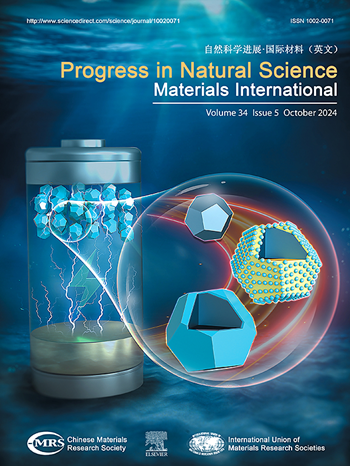Recent advances in photopolymerization 3D printing of alumina-ceramic
IF 7.1
2区 材料科学
Q2 MATERIALS SCIENCE, MULTIDISCIPLINARY
Progress in Natural Science: Materials International
Pub Date : 2025-02-01
DOI:10.1016/j.pnsc.2024.07.013
引用次数: 0
Abstract
Digital light processing (DLP) 3D printing has a huge potential for manufacturing intricate and customized ceramic parts with high precision and cost-effectiveness. Research in this field contributes to material innovation, opening the avenues for new process designs in both scientific and industrial sectors. However, the implementation of DLP 3D printing technology in ceramic research has not yet reached the maturity level as that in polymer and tissue engineering. Necessarily, a holistic in-depth literature reporting the successful integration of alumina ceramics within DLP 3D printing technology is urgently needed. This review, systematic examines recent progress in DLP technology, focusing on photopolymer resins that incorporate UV-sensitive monomers, photoinitiators, and dispersants, as well as their synergistic effects on achieving high-quality printing, desirable material properties, and enhanced performance. Further, the review discusses key factors including post-processing characteristics such as debinding and sintering, which influence microstructure, and defect formation including microcracks, porosity and voids. Finally, the challenges associated with printing and sintering are highlighted, aiming to identify focused focused development pathways and potential solution to optimize outcomes. This analysis clarifies existing challenges and also propsoes future applications for DLP technology in the alumina-ceramic field.
氧化铝陶瓷光聚合3D打印研究进展
数字光处理(DLP) 3D打印在制造复杂的定制陶瓷零件方面具有巨大的潜力,具有高精度和成本效益。该领域的研究有助于材料创新,为科学和工业领域的新工艺设计开辟了道路。然而,DLP 3D打印技术在陶瓷研究中的应用还没有达到聚合物和组织工程中的成熟水平。因此,迫切需要一篇全面深入的文献报道氧化铝陶瓷在DLP 3D打印技术中的成功集成。本文系统地回顾了DLP技术的最新进展,重点介绍了光聚合物树脂,这些树脂包含了感光单体、光引发剂和分散剂,以及它们在实现高质量印刷、理想材料性能和增强性能方面的协同作用。此外,本文还讨论了影响微观结构的后处理特性(如脱脂和烧结)和缺陷形成(包括微裂纹、孔隙和空隙)等关键因素。最后,强调了与印刷和烧结相关的挑战,旨在确定重点关注的发展途径和潜在的解决方案,以优化结果。该分析澄清了现有的挑战,并提出了DLP技术在氧化铝陶瓷领域的未来应用。
本文章由计算机程序翻译,如有差异,请以英文原文为准。
求助全文
约1分钟内获得全文
求助全文
来源期刊
CiteScore
8.60
自引率
2.10%
发文量
2812
审稿时长
49 days
期刊介绍:
Progress in Natural Science: Materials International provides scientists and engineers throughout the world with a central vehicle for the exchange and dissemination of basic theoretical studies and applied research of advanced materials. The emphasis is placed on original research, both analytical and experimental, which is of permanent interest to engineers and scientists, covering all aspects of new materials and technologies, such as, energy and environmental materials; advanced structural materials; advanced transportation materials, functional and electronic materials; nano-scale and amorphous materials; health and biological materials; materials modeling and simulation; materials characterization; and so on. The latest research achievements and innovative papers in basic theoretical studies and applied research of material science will be carefully selected and promptly reported. Thus, the aim of this Journal is to serve the global materials science and technology community with the latest research findings.
As a service to readers, an international bibliography of recent publications in advanced materials is published bimonthly.

 求助内容:
求助内容: 应助结果提醒方式:
应助结果提醒方式:


